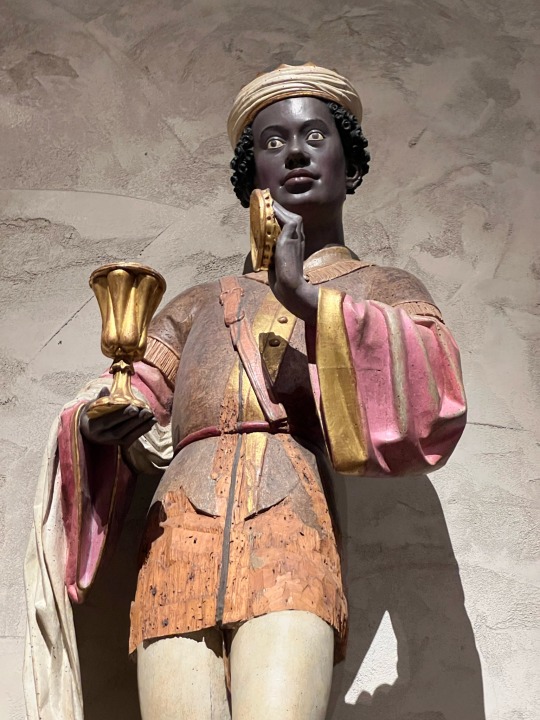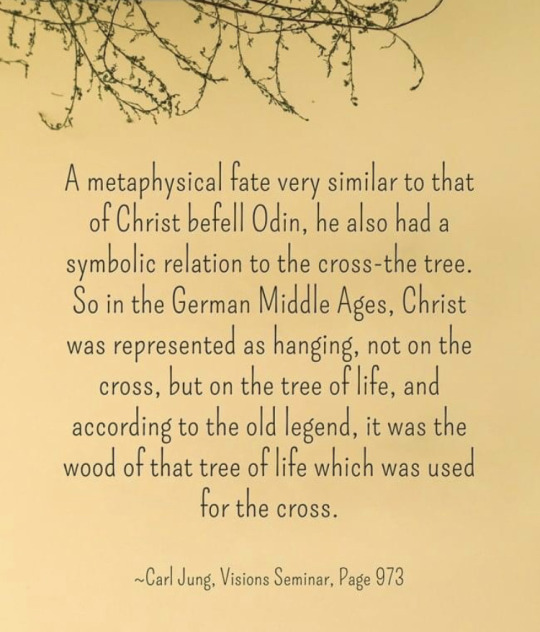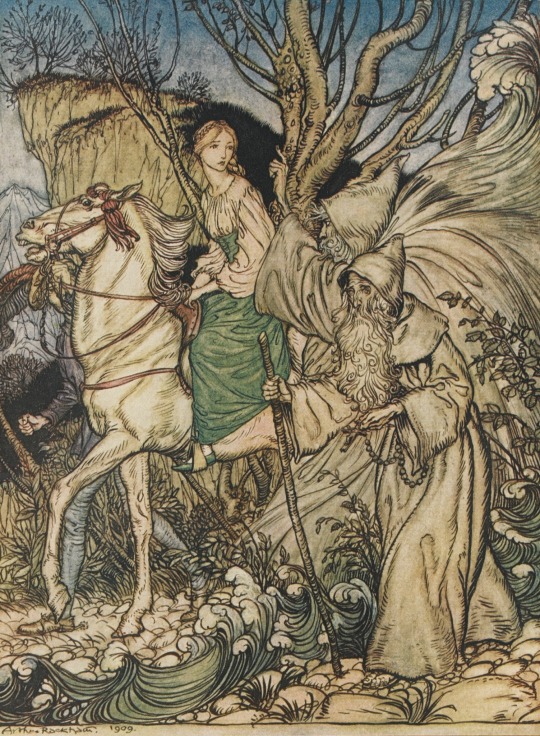#medieval Germany
Text

Josaphat Converses with the Astrologers, 1469
Follower of Hans Schilling (German, active 1459 - 1467), illuminator and from the Workshop of Diebold Lauber (German, active 1427 - 1467), illuminator
Ink, colored washes, and tempera colors
The J. Paul Getty Museum, Los Angeles, Ms. Ludwig XV 9, fol. 27, 83.MR.179.27
14 notes
·
View notes
Text
Mercurius, from 'Iatromathematisches Hausbuch', Bavaria, c. 1477-1496, Cod. Pal. germ. 291, Universitätsbibliothek Heidelberg.

#mercury#wednesday#astrological#astrology#medieval germany#astrological art#late medieval#occult art#15th century#late 15th century
40 notes
·
View notes
Text

Black Magus, Germany, 15th century. Photo by me.
From the Met Cloisters.
14 notes
·
View notes
Text

A metaphysical fate very similar to that of Christ befell Odin; he also had a symbolic relation to the cross – the tree. So in the German middle ages, Christ was represented as hanging, not on the cross, but on the tree of life, and according to the old legend, it was the word of that tree of life which was used for the cross.
#spirituality#carl jung#Odin#Christ#tree of life#Middle Ages#medieval Germany#cross#comparative religion#jungian psychology
24 notes
·
View notes
Text

Suit of Hearts, from The Playing Cards of Peter Flötner, ca. 1540
#renaissance#renaissance art#renaissance Germany#medieval#medieval art#medieval Germany#history#art history#German art#pretty
1 note
·
View note
Text
youtube
Grey (2021) [5 min] by Vasilina Mikhaylova | USA
#2D#2D Animation#2021#5 min#Vasilina Mikhaylova#USA#Animated Short#AnimatedShortOfTheDay#Animation#Wolf#Forest#Winter#LMU#Medieval Germany#Youtube
0 notes
Text

Burg Eltz, Wierschem, Germany,
Photo by @diewelselvis
#art#design#architecture#history#luxury lifestyle#style#luxury house#luxury home#castle#burg#burg eltz#germany#medieval#wierschem#diewels elvis
701 notes
·
View notes
Text

☆
@hypxrreal
#architecture#medieval#gothic#cathedral#dark academia#dark and moody#moody#moody aesthetic#gloomy#gloomcore#gloomy aesthetic#cottagecore#germany#mine#medieval art#gothic art#europe#romantic academia#gloom#dark aesthetic
241 notes
·
View notes
Text

Woodcut of St. Clare of Assisi, Germany, ca. 1470–80
Rosenwald Collection, National Gallery of Art
276 notes
·
View notes
Text

Reliquary bust of St. Mary Magdalene by Michel Erhart, c. 1475-80
#michel erhart#german style#germany#15th c. Germany#15th century#bust#religious art#mdpsculpture#sculpture#15th c. sculpture#1470s#medieval#gothic#headdress
779 notes
·
View notes
Text

Undine by Arthur Rackham
#undine#art#arthur rackham#illustration#friedrich de la motte fouqué#fairytale#fairy tale#germany#german#water spirit#mythology#mythological#supernatural#soul#medieval#knight#europe#european#romance#paracelsus#esoteric#ondine#fairy tales#folklore#fairy#mermaid#history#romantic
407 notes
·
View notes
Text

King Avenir Hunting Wild Boar, 1469
From the Workshop of Diebold Lauber (German, active 1427 - 1467), illuminator
The J. Paul Getty Museum, Los Angeles, Ms. Ludwig XV 9, fol. 12, 83.MR.179.12
9 notes
·
View notes
Text
Richard Kieckhefer. Forbidden Rites: A Necromancer's Manual of the Fifteenth Century, Magic in History Series. University Park, PA: The Pennsylvania State University Press, 2016. Paperback edition. 384 pages.
Shop link in bio.
instagram
#occult#magic#bookseller#esotericism#occult books#western esotericism#necromantic#necromancy#medieval magic#medieval germany#medieval history#grimore#grimoires#demons#conjuration#Instagram
4 notes
·
View notes
Text

#Altenburg#art history#sainted places#germany#gothic#architecture#baroque#churches#cathedral#medieval
416 notes
·
View notes
Text

Medieval Game Pieces Emerge From the Ruins of a German Castle
A small cache of medieval game pieces has been discovered in the ruins of a recently discovered castle in southern Germany. The finds provide a window into leisure time, possibly among actual knights, dating back nearly a millennium, approximately the time that chess arrived in Europe as an import from Asia.
The find includes a six-sided die, assorted game pieces including four in the shape of flowers, and a very well-preserved 1½-inch-high chess piece, all carved from antlers.
“In the Middle Ages, chess was one of the seven skills that a good knight should master,” said Jonathan Scheschkewitz, of the State Office for the Preservation of Monuments Baden-Württemberg. “It is therefore not surprising that known finds mostly come from castles.”
There is evidence that these are not just display objects, but pieces that were actually used. “Under the microscope,” explained Flavia Venditti of the University of Tübingen, “a typical sheen from holding and moving the pieces can be seen.”

An international team of experts from the University of Tübingen, the State Office for the Preservation of Monuments Baden-Württemberg and the German Archaeological Institute is now examining this evidence of early gaming culture.
“The discovery of an entire games collection [from] the 11th/12th century came as a complete surprise to us,” said Lukas Werther, of the German Archaeological Institute, “and the horse-shaped knight piece is a real highlight.”
The pieces came to light during excavations by the DFG Collaborative Research Centre 1070 Resource Cultures and the State Office for the Preservation of Monuments Baden-Württemberg in a previously unknown castle in the Reutlingen district of southern Germany’s Baden-Württemberg region.


“They were lying under the debris of a wall where they were lost or hidden in the Middle Ages,” said Michael Kienzle of the University of Tübingen. They are in such good condition, he added, precisely because they had been covered under those materials.
They will go on display this month in two exhibitions: “Excavated! Knights and Castles in the Echaz Valley” at the Schlössle Pfullingen (June 15–August 30) and “The Hidden Länd: We in the First Millennium” at the Archaologisches Landsmuseum Baden-Württemberg (September 13, 2024–January 26, 2025).

#Medieval Game Pieces Emerge From the Ruins of a German Castle#Germany’s Baden-Württemberg region#ancient artifacts#archeology#archeolgst#history#history news#ancient history#ancient culture#ancient civilizations#middle ages#medieval history#medieval art
347 notes
·
View notes
Text





A small breech-loading Cannon,
Barrel Length: 14.4 in/36.7 cm
Bore: 1.3 in/3.4 cm
possibly Germany, late 15th century, from Olympia Auction House.
#weapons#firearms#artillery#cannon#europe#european#germany#german#hre#holy roman empire#medieval#middle ages#renaissance#olympia auctions#art#history
187 notes
·
View notes